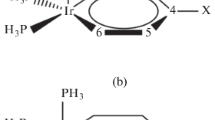Abstract
The changes of bond dissociation energy (BDE) in the C–NO2 bond and nitro group charge upon the formation of the intermolecular hydrogen-bonding interaction between HF and the nitro group of 14 kinds of nitrotriazoles or methyl derivatives were investigated using the B3LYP and MP2(full) methods with the 6-311++G**, 6-311++G(2df,2p) and aug-cc-pVTZ basis sets. The strength of the C–NO2 bond was enhanced and the charge of nitro group turned more negative in complex in comparison with those in isolated nitrotriazole molecule. The increment of the C–NO2 bond dissociation energies correlated well with the intermolecular H-bonding interaction energies. Electron density shifts analyses showed that the electron density shifted toward the C–NO2 bond upon complex formation, leading to the strengthened C–NO2 bond and the possibly reduced explosive sensitivity.

C1-N2 bond turns strong upon H-bond formation, leading to a possibly reduced explosive sensitivity



Similar content being viewed by others
References
Hu TP, Ren FD, Ren J (2009) J Mol Struct (THEOCHEM) 909:13–18
Richard RM, Ball DW (2008) J Mol Struct (THEOCHEM) 851:284–293
Qiu L, Gong XD, Zheng J, Xiao HM (2009) J Hazard Mater 166:931–938
Wang GX, Gong XD, Liu Y, Xiao HM (2009) Spectrochim Acta Part A 74:569–574
Liu Y, Gong XD, Wang LJ, Wang GX, Xiao HM (2011) J Phys Chem A 115:1754–1762
Keshavarz MH, Pouretedal HR (2010) Propell Explos Pyrot 35:175–181
Pospíšil M, Vávra P, Concha MC, Murray JS, Politzer P (2010) J Mol Model 16:895–901
Zhao J, Xu DH, Cheng XL (2010) Struct Chem 21:1235–1240
Li JS (2010) J Hazard Mater 174:728–733
Li JS (2010) J Hazard Mater 180:768–772
Atalar T, Jungová M, Zeman S (2009) J Energ Mater 27:200–216
Cao CZ, Gao S (2007) J Phys Chem B 111:12399–12402
Zhao J, Cheng XL, He B, Yang XD (2006) Struct Chem 17:501–507
Song XS, Cheng XL, Yang XD, He B (2006) Propell Explos Pyrot 31:306–310
Zhang CY, Shu YJ, Huang YG, Zhao XD, Dong HS (2005) J Phys Chem B 109:8978–8982
Rice BM, Hare JJ (2002) J Phys Chem A 106:1770–1783
Tan BS, Long XP, Peng RF, Li HB, Jin B, Chu SJ, Dong HS (2010) J Hazard Mater 183:908–912
Delpuech A, Cherville J (1979) Propell Explos Pyrot 4:121–128
Xiao HM (1994) Molecular orbital theory of nitro-compound. Publishing House of Defense Industry, Peking
Li JS (2010) J Phys Chem B 114:2198–2202
Owens FJ, Jayasuriya K, Abrahmsen L, Politzer P (1985) Chem Phys Lett 116:434–438
Ren WZ, Wang ZS (2004) Explosive theory and practice. China North Chemical Industries Corp Press, Nanjing
Yang L, Zhang J, Zhang T, Zhang J, Cui Y (2009) J Hazard Mater 164:962–967
Buszewski B, Michel M, Cudziło S, Chyłek Z (2009) J Hazard Mater 164:1051–1058
Wang HB, Shi WJ, Ren FD, Yang L, Wang JL (2012) Comp Theor Chem doi:10.1016/j.comptc.2012.06.018
Xue H, Gao Y, Wamley BT, Shreeve JM (2005) Chem Mater 17:191–198
Sikder AK, Geetha M, Sarwade DB, Agrrawal JP (2001) J Hazard Mater A 82:1–12
Li XH, Zhang RZ, Zhang XZ (2011) Struct Chem 22:577–587
Vereshchyagin LI, Pokatilov FA, Kizhnyaev VN (2008) Chem Heterocycl Compd 44:3–25
Sukhanov GT, Sukhanova AG, Lukin AY (2007) Chem Heterocycl Compd 43:786–792
Sukhanova AG, Sakovich GV, Sukhanov GT (2008) Chem Heterocycl Compd 44:1368–1373
Duddu R, Dave PR, Damavarapu R, Surapaneni R, Parrish D (2009) Synth Commun 39:4282–4288
Darren LN, Michael AH, Herbert HH (2003) J Energ Mater 21:57–62
Yi JH, Zhao FQ, Ren YH, Xu SY, Ma HX, Hu RZ (2010) J Therm Anal Calorim 100:623–627
Ma HX, Song JR, Hu RZ, Zhai GH, Xu KZ, Wen ZY (2004) J Mol Struct (THEOCHEM) 678:217–222
Song JR, Ma HX, Huang J, Hu RZ (2004) Thermochim Acta 416:43–46
Wang YM, Chen C, Lin ST (1999) J Mol Struct (THEOCHEM) 460:79–102
Yim WL, Liu ZF (2001) J Am Chem Soc 10:2243–2250
Ravi P, Babu BK, Tewari SP (2012) J Mol Model. doi:10.1007/s00894-012-1515-z
Pourmortazavi SM, Rahimi-Nasrabadi M, Kohsari I, Hajimirsadeghi SS (2011) J Therm Anal Calorim. doi:10.1007/s10973-011-1845-6
Fabio R, Luigi B, Gustavo P, Aldo D (1994) Struct Chem 1:1–7
Fang G, Xu L, Hu X, Li X (2008) J Hazard Mater 160:51–55
Zheng ZB, Wu RT, Li JK, Sun YF (2009) J Mol Struct 928(2009):78–84
Richard RM, Ball DW (2007) J Mol Struct (THEOCHEM) 806:113–120
Tanaka N, Tamezane T, Nishikiori H, Fujii T (2003) J Mol Struct (THEOCHEM) 631:21–28
Novoa JJ, Mota F (2000) Chem Phys Lett 318:345–354
Frisch MJ et al. (2003) Gaussian 03, Revision B.03, Gaussian Inc, Pittsburgh, PA
Scheiner S, Kar T (2002) J Phys Chem A 106:1784–1789
Duijineveldt FB, Duijineveldt-van de Rijdt JCMV, Lenthe JHV (1994) Chem Rev 94:1873–1885
Boys SF, Bernardi F (1970) Mol Phys 19:553–566
Macaveiu L, Göbel M, Klapötke TM, Murray JS, Politzer P (2010) Struct Chem 21:139–146
Budyka MF, Zyubina TS, Zarkadis AK (2002) J Mol Struct (THEOCHEM) 594:113–125
Jursic BS (1996) J Mol Struct (THEOCHEM) 366:103–108
Brinck T, Haeberlin M, Jonsson M (1997) J Am Chem Soc 119:4239–4244
Barckholtz C, Barckholtz TA, Hadad CM (1999) J Am Chem Soc 121:491–500
Brill TB, James KJ (1993) Chem Rev 93:2667–2692
Murray JS, Concha MC, Politzer P (2009) Mol Phys 107:89–97
Politzer P, Lane P, Murray JS (2011) Cent Europ J Energ Mater 8:39–52
Author information
Authors and Affiliations
Corresponding authors
Rights and permissions
About this article
Cite this article
Li, BH., Shi, Wj., Ren, Fd. et al. A B3LYP and MP2(full) theoretical investigation into the strength of the C–NO2 bond upon the formation of the intermolecular hydrogen-bonding interaction between HF and the nitro group of nitrotriazole or its methyl derivatives. J Mol Model 19, 511–519 (2013). https://doi.org/10.1007/s00894-012-1574-1
Received:
Accepted:
Published:
Issue Date:
DOI: https://doi.org/10.1007/s00894-012-1574-1




